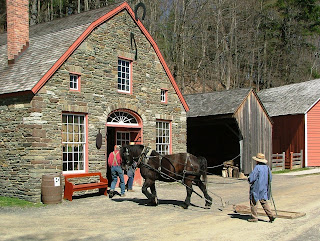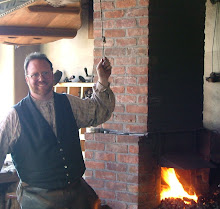In March of 2009 the Lippitt Farm staff at The Farmers’ Museum brought an 1830’s plow to the Field’s Blacksmith Shop. The plow was in rough shape. It had been purchased at a local antique store for use in demonstrations. Only the core parts were intact. The moldboard, plow point, and shin were fine. We have been working on it as time allowed for a year and a month. Here is Farmer Wayne polishing decades of rust from the mouldboard by scrubbing it with an old soft brick:
All of the wooden parts and most of the bolts and brackets were rotten, rusted, worn or missing. Here is the original wooden beam. It still retained the holes and rust stains to indicate where hardware was missing. Our task became to figure out what parts were needed and to make them.
We set out to repair the plow using historically accurate methods and to put it back into use at The Farmers’ Museum. Farmer Wayne carved a replacement wooden plow beam by using the decayed original as a model. Here is the new beam and some of the newly forged bolts.
I made plow bolts, carriage bolts, and a 24-inch long by 1/4” stretcher bolt, and nuts. We also made the gauge wheel bracket.
Our last forging project is the largest. We are forging a replacement knife coulter blade. This is the part of the plow that cuts the sod and roots before the plow rolls the soil and sod over. It is a heavy piece. We have forged it using two and three smiths at a time. The finished part looks simple but will have taken about 16 hours of work.
This plow is a great example of plows as used in the 1830’s. It has probably not been used in the last 80 to 100 years. Our plowing is about to start. We plow our gardens, hop fields, potato field, and grain plots. Returning this piece of historic equipment to use has been a long road. My thanks to the farmers Rick, Wayne, and Marieanne for making this project possible. I think the farmers are even more excited than I about the chance to put the 1830’s plow to use!
The maiden voyage of this tool will involve adjusting the bite and the draft of the plow. That controlled the width of the plowed strip and the depth of cut. Zeb our Percheron draft horse will pull the plow for this test. It will be hard work, but he is a plowing veteran. This is his 13th year of plowing at The Farmers’ Museum.
After Zeb helps us to fine-tune the plow it will be used by our team of oxen. Jigs and Buckwheat have never had such an important and difficult job to do at the farm. They will earn their hay this summer!
Check back soon. We will post a video later this week of the 1830’s plow being used once again!

































